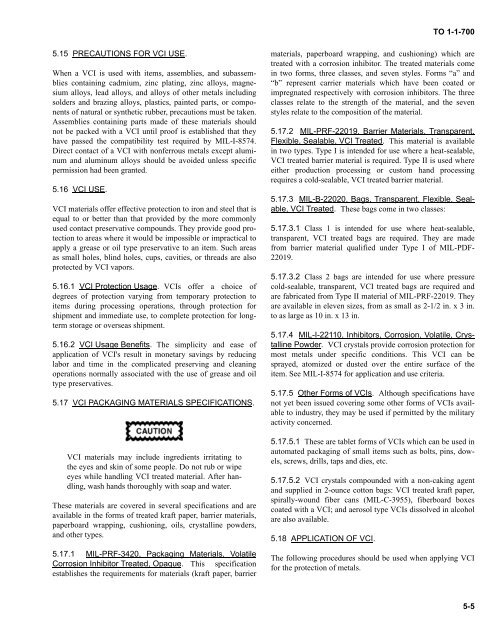TO 1-1-700 - Robins Air Force Base
TO 1-1-700 - Robins Air Force Base
TO 1-1-700 - Robins Air Force Base
Create successful ePaper yourself
Turn your PDF publications into a flip-book with our unique Google optimized e-Paper software.
<strong>TO</strong> 1-1-<strong>700</strong><br />
5.15 PRECAUTIONS FOR VCI USE.<br />
When a VCI is used with items, assemblies, and subassemblies<br />
containing cadmium, zinc plating, zinc alloys, magnesium<br />
alloys, lead alloys, and alloys of other metals including<br />
solders and brazing alloys, plastics, painted parts, or components<br />
of natural or synthetic rubber, precautions must be taken.<br />
Assemblies containing parts made of these materials should<br />
not be packed with a VCI until proof is established that they<br />
have passed the compatibility test required by MIL-I-8574.<br />
Direct contact of a VCI with nonferrous metals except aluminum<br />
and aluminum alloys should be avoided unless specific<br />
permission had been granted.<br />
5.16 VCI USE.<br />
VCI materials offer effective protection to iron and steel that is<br />
equal to or better than that provided by the more commonly<br />
used contact preservative compounds. They provide good protection<br />
to areas where it would be impossible or impractical to<br />
apply a grease or oil type preservative to an item. Such areas<br />
as small holes, blind holes, cups, cavities, or threads are also<br />
protected by VCI vapors.<br />
5.16.1 VCI Protection Usage. VCIs offer a choice of<br />
degrees of protection varying from temporary protection to<br />
items during processing operations, through protection for<br />
shipment and immediate use, to complete protection for longterm<br />
storage or overseas shipment.<br />
5.16.2 VCI Usage Benefits. The simplicity and ease of<br />
application of VCI's result in monetary savings by reducing<br />
labor and time in the complicated preserving and cleaning<br />
operations normally associated with the use of grease and oil<br />
type preservatives.<br />
5.17 VCI PACKAGING MATERIALS SPECIFICATIONS.<br />
VCI materials may include ingredients irritating to<br />
the eyes and skin of some people. Do not rub or wipe<br />
eyes while handling VCI treated material. After handling,<br />
wash hands thoroughly with soap and water.<br />
These materials are covered in several specifications and are<br />
available in the forms of treated kraft paper, barrier materials,<br />
paperboard wrapping, cushioning, oils, crystalline powders,<br />
and other types.<br />
5.17.1 MIL-PRF-3420, Packaging Materials, Volatile<br />
Corrosion Inhibitor Treated, Opaque. This specification<br />
establishes the requirements for materials (kraft paper, barrier<br />
materials, paperboard wrapping, and cushioning) which are<br />
treated with a corrosion inhibitor. The treated materials come<br />
in two forms, three classes, and seven styles. Forms “a” and<br />
“b” represent carrier materials which have been coated or<br />
impregnated respectively with corrosion inhibitors. The three<br />
classes relate to the strength of the material, and the seven<br />
styles relate to the composition of the material.<br />
5.17.2 MIL-PRF-22019, Barrier Materials, Transparent,<br />
Flexible, Sealable, VCI Treated. This material is available<br />
in two types. Type I is intended for use where a heat-sealable,<br />
VCI treated barrier material is required. Type II is used where<br />
either production processing or custom hand processing<br />
requires a cold-sealable, VCI treated barrier material.<br />
5.17.3 MIL-B-22020, Bags, Transparent, Flexible, Sealable,<br />
VCI Treated. These bags come in two classes:<br />
5.17.3.1 Class 1 is intended for use where heat-sealable,<br />
transparent, VCI treated bags are required. They are made<br />
from barrier material qualified under Type I of MIL-PDF-<br />
22019.<br />
5.17.3.2 Class 2 bags are intended for use where pressure<br />
cold-sealable, transparent, VCI treated bags are required and<br />
are fabricated from Type II material of MIL-PRF-22019. They<br />
are available in eleven sizes, from as small as 2-1/2 in. x 3 in.<br />
to as large as 10 in. x 13 in.<br />
5.17.4 MIL-I-22110, Inhibitors, Corrosion, Volatile, Crystalline<br />
Powder. VCI crystals provide corrosion protection for<br />
most metals under specific conditions. This VCI can be<br />
sprayed, atomized or dusted over the entire surface of the<br />
item. See MIL-I-8574 for application and use criteria.<br />
5.17.5 Other Forms of VCIs. Although specifications have<br />
not yet been issued covering some other forms of VCIs available<br />
to industry, they may be used if permitted by the military<br />
activity concerned.<br />
5.17.5.1 These are tablet forms of VCIs which can be used in<br />
automated packaging of small items such as bolts, pins, dowels,<br />
screws, drills, taps and dies, etc.<br />
5.17.5.2 VCI crystals compounded with a non-caking agent<br />
and supplied in 2-ounce cotton bags: VCI treated kraft paper,<br />
spirally-wound fiber cans (MIL-C-3955), fiberboard boxes<br />
coated with a VCI; and aerosol type VCIs dissolved in alcohol<br />
are also available.<br />
5.18 APPLICATION OF VCI.<br />
The following procedures should be used when applying VCI<br />
for the protection of metals.<br />
5-5
















